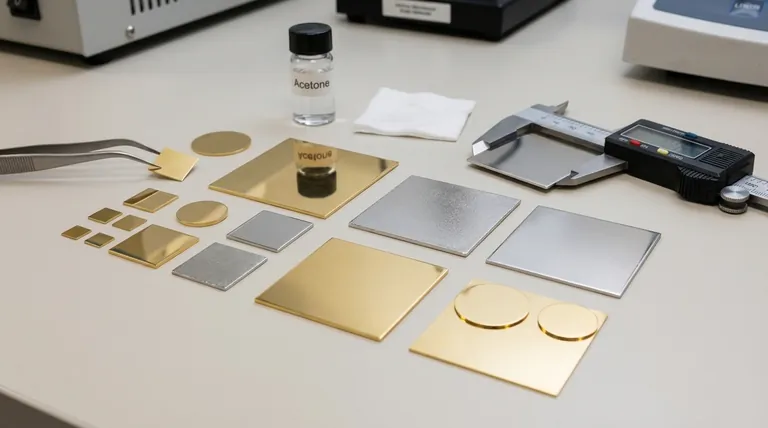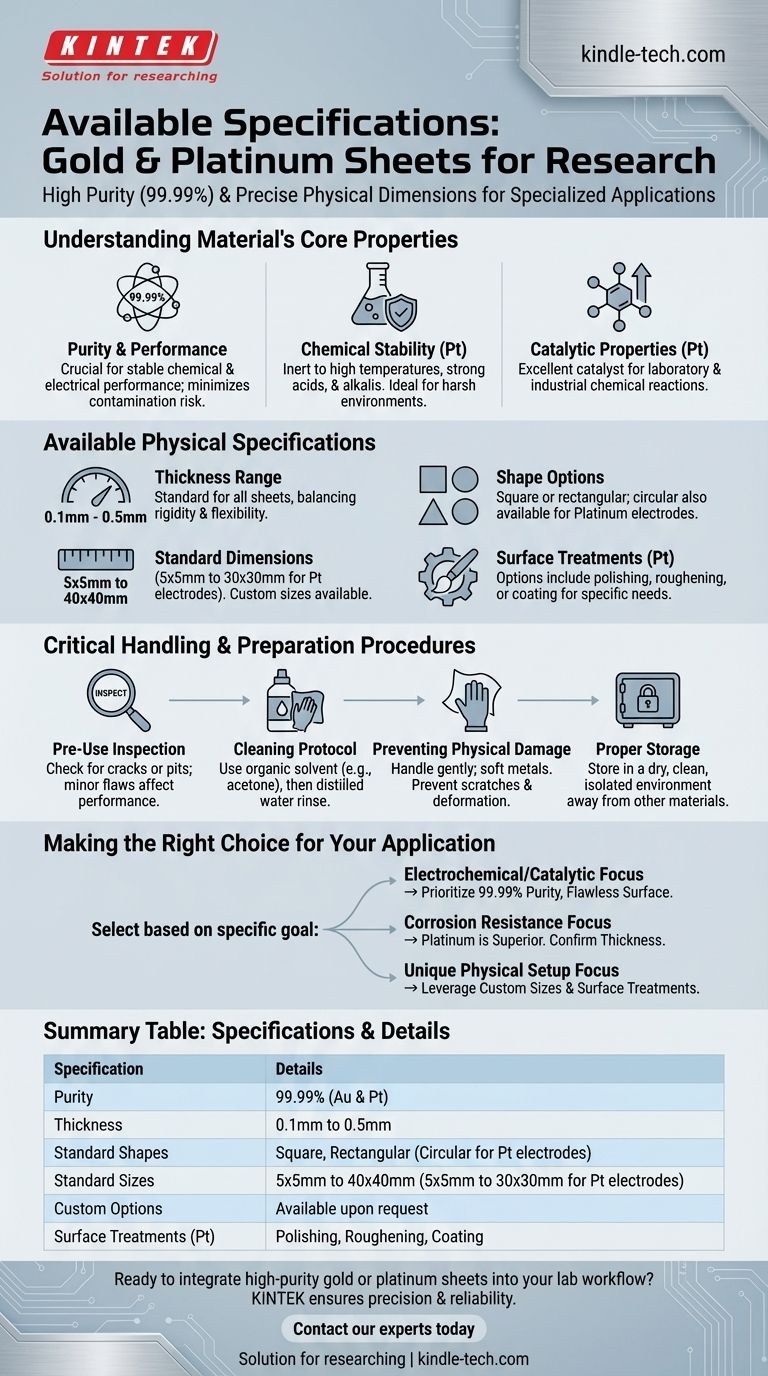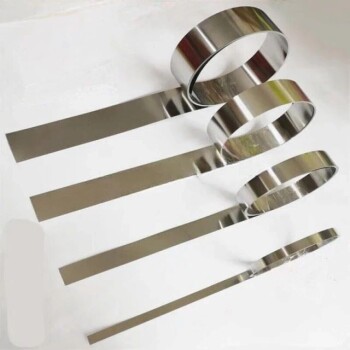The available specifications for gold and platinum sheets focus on high purity and precise physical dimensions for specialized applications. These sheets are available in square or rectangular shapes with a purity of 99.99%, a thickness ranging from 0.1mm to 0.5mm, and standard dimensions from 5x5mm up to 40x40mm. Custom sizes and, for platinum, specific surface treatments are also available upon request.
While the physical dimensions are straightforward, the true value of these sheets lies in their exceptional purity and chemical properties. Proper handling and pre-use inspection are therefore as critical as the initial specifications to ensure reliable and stable performance.

Understanding the Material's Core Properties
To select the right sheet, you must first understand the fundamental characteristics that define its performance. These properties are the reason these materials are chosen for high-precision and demanding applications.
Purity and Performance
The sheets are made from gold or platinum with a purity of 99.99%. This high level of purity is crucial as it ensures stable, predictable chemical and electrical performance, minimizing the risk of contamination in sensitive reactions or measurements.
Chemical Stability of Platinum
Platinum exhibits extremely high chemical stability. It remains inert even when exposed to high temperatures, strong acids, and strong alkalis. This makes it an ideal material for corrosion-resistant reaction vessels and other components used in harsh chemical environments.
Catalytic Properties
Beyond its stability, platinum possesses excellent catalytic properties. This allows it to serve as a catalyst for a wide range of chemical reactions, a primary application in both laboratory and industrial settings.
Available Physical Specifications
The physical dimensions of the sheets can be tailored to meet the needs of your specific equipment or experimental setup.
Shape and Thickness
The sheets are most commonly produced in square or rectangular forms. Platinum electrode sheets are also available in a circular shape. The standard thickness for all sheets ranges from 0.1mm to 0.5mm, offering a balance between rigidity and flexibility.
Standard and Custom Dimensions
Standard dimensions for gold and platinum sheets range from 5x5mm to 40x40mm. For platinum electrode sheets specifically, the standard range is typically 5x5mm to 30x30mm. If these sizes do not meet your requirements, custom dimensions can be requested.
Surface Treatment Options
For applications requiring modified surface characteristics, platinum sheets can undergo special treatments. These options include polishing, roughening, or coating, which can expand their utility for specific catalytic or electrochemical purposes.
Critical Handling and Preparation Procedures
The high value and sensitive nature of these materials demand meticulous care. Improper handling can easily compromise their integrity and performance.
Pre-Use Inspection
Before any use, you must inspect the sheet's surface for damage like cracks or pits. Even minor physical flaws can significantly affect performance in high-precision applications.
Cleaning Protocol
If any impurities are visible, clean the surface with an organic solvent like acetone to remove oils or contaminants. Afterward, rinse the sheet thoroughly with distilled water to ensure a pure, reactive surface.
Preventing Physical Damage
Both gold and platinum are soft metals. It is critical to handle them gently to prevent scratches or deformation. Repairs can be complex and costly, so preventative care is paramount.
Proper Storage
Store the sheets in a dry, clean, and isolated environment. This prevents accidental scratches from contact with other materials and avoids unwanted chemical reactions or surface contamination.
Making the Right Choice for Your Application
Selecting the correct specification is about matching the material's properties and condition to your specific goal.
- If your primary focus is electrochemical or catalytic performance: Prioritize the 99.99% purity and ensure the surface is flawlessly clean and inspected before use.
- If your primary focus is corrosion resistance in harsh environments: Platinum is the superior choice; confirm the thickness is adequate for the structural demands of the application.
- If your primary focus is a unique physical setup: Leverage the availability of custom sizing and, for platinum, surface treatments like roughening to fit your exact requirements.
Ultimately, careful selection and meticulous handling are the keys to unlocking the high-performance potential of these materials.
Summary Table:
| Specification | Details |
|---|---|
| Purity | 99.99% (Au & Pt) |
| Thickness | 0.1mm to 0.5mm |
| Standard Shapes | Square, Rectangular (Circular for Pt electrodes) |
| Standard Sizes | 5x5mm to 40x40mm (5x5mm to 30x30mm for Pt electrodes) |
| Custom Options | Available upon request |
| Surface Treatments (Pt) | Polishing, Roughening, Coating |
Ready to integrate high-purity gold or platinum sheets into your lab workflow?
KINTEK specializes in providing premium lab equipment and consumables, including these high-purity sheets, to ensure precision and reliability in your most critical applications. Our materials are designed to deliver stable chemical and electrical performance, crucial for sensitive experiments and industrial processes.
Contact our experts today to discuss your specific requirements for custom sizes or surface treatments, and let us help you achieve superior results.
Visual Guide

Related Products
- High-Purity Titanium Foil and Sheet for Industrial Applications
- Platinum Sheet Electrode for Laboratory and Industrial Applications
- High Purity Zinc Foil for Battery Lab Applications
- Aluminum Foil Current Collector for Lithium Battery
- Battery Lab Equipment 304 Stainless Steel Strip Foil 20um Thick for Battery Test
People Also Ask
- What are the advantages disadvantages and uses of sheet metal? The Ultimate Guide to Material Selection
- What are the disadvantages of using metal? Understanding Corrosion, Weight, and Cost Challenges
- What is the difference between metallic and non-metallic coating? A Guide to Sacrificial vs. Barrier Protection
- How does hardness change with temperature? Understand the Inverse Relationship to Prevent Failure
- What products are manufactured with titanium? The Ultimate Guide to High-Performance Materials






